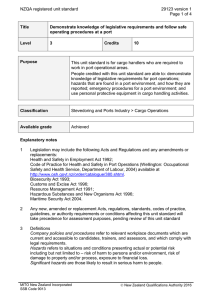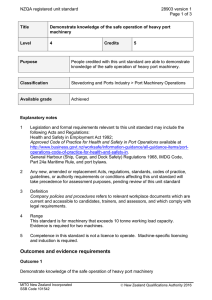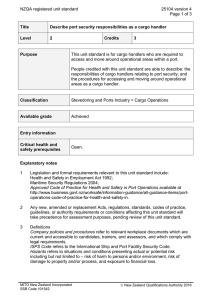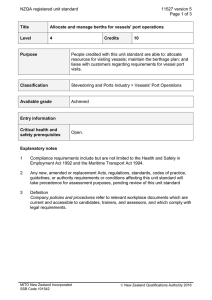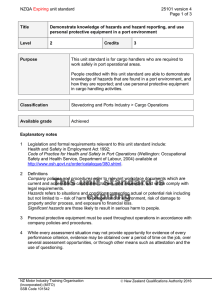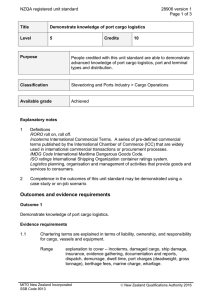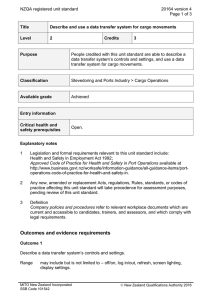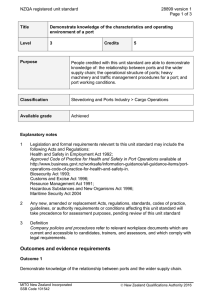NZQA unit standard 25101 version 4 Page 1 of 4 Title Demonstrate
advertisement
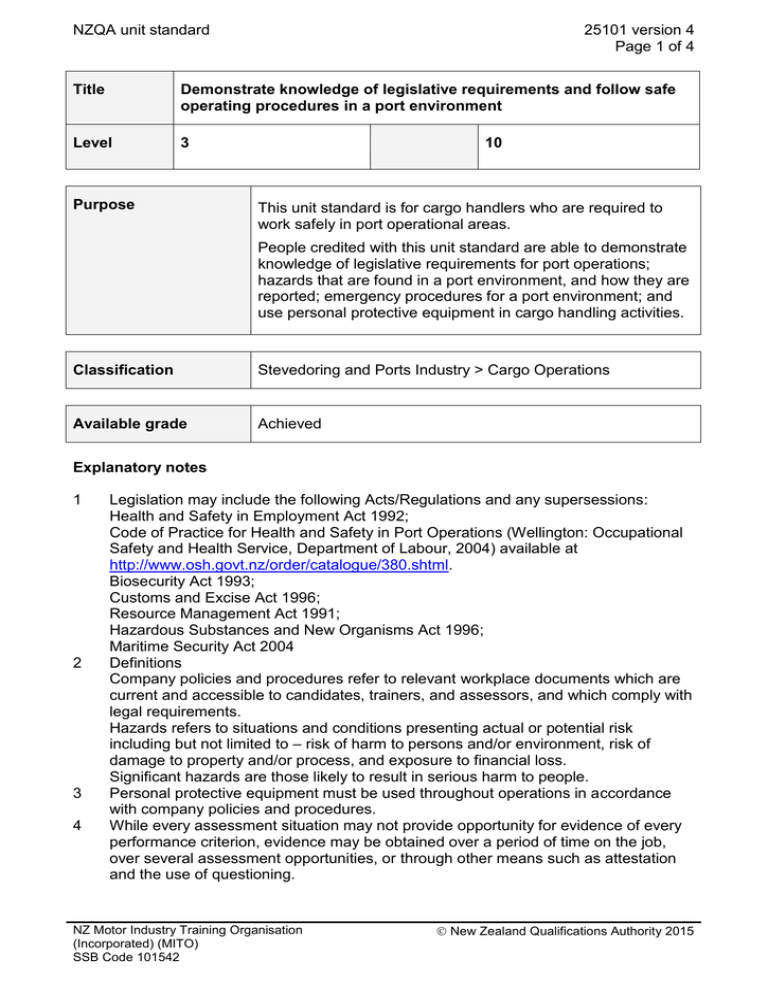
NZQA unit standard 25101 version 4 Page 1 of 4 Title Demonstrate knowledge of legislative requirements and follow safe operating procedures in a port environment Level 3 Purpose 10 This unit standard is for cargo handlers who are required to work safely in port operational areas. People credited with this unit standard are able to demonstrate knowledge of legislative requirements for port operations; hazards that are found in a port environment, and how they are reported; emergency procedures for a port environment; and use personal protective equipment in cargo handling activities. Classification Stevedoring and Ports Industry > Cargo Operations Available grade Achieved Explanatory notes 1 2 3 4 Legislation may include the following Acts/Regulations and any supersessions: Health and Safety in Employment Act 1992; Code of Practice for Health and Safety in Port Operations (Wellington: Occupational Safety and Health Service, Department of Labour, 2004) available at http://www.osh.govt.nz/order/catalogue/380.shtml. Biosecurity Act 1993; Customs and Excise Act 1996; Resource Management Act 1991; Hazardous Substances and New Organisms Act 1996; Maritime Security Act 2004 Definitions Company policies and procedures refer to relevant workplace documents which are current and accessible to candidates, trainers, and assessors, and which comply with legal requirements. Hazards refers to situations and conditions presenting actual or potential risk including but not limited to – risk of harm to persons and/or environment, risk of damage to property and/or process, and exposure to financial loss. Significant hazards are those likely to result in serious harm to people. Personal protective equipment must be used throughout operations in accordance with company policies and procedures. While every assessment situation may not provide opportunity for evidence of every performance criterion, evidence may be obtained over a period of time on the job, over several assessment opportunities, or through other means such as attestation and the use of questioning. NZ Motor Industry Training Organisation (Incorporated) (MITO) SSB Code 101542 New Zealand Qualifications Authority 2015 NZQA unit standard 25101 version 4 Page 2 of 4 Outcomes and evidence requirements Outcome 1 Demonstrate knowledge of legislative requirements for port operations Evidence requirements 1.1 Employer and employee responsibilities for a port operations work environment are explained in accordance with the Health and Safety in Employment Act 1992. 1.2 The Health and Safety in Employment Act is explained in terms of general overview implications to a port operations working environment. Range includes but is not limited to – regulations, hazards, confined space, working at heights. 1.3 General Biosecurity requirements at ports are explained in accordance with the Biosecurity Act 1993. 1.4 General customs requirements at ports are explained in accordance with the Customs and Excise Act 1996. 1.5 Potential applications of the Resource Management Act are explained for a port operations environment. Range 1.6 Potential applications on the Maritime Security Act are explained for a port operations environment. Range 1.7 minimum of one application. minimum of one application. Potential applications of best practice guidelines or codes of practice are explained for a port working environment. Range minimum of one application. Outcome 2 Demonstrate knowledge of hazards that are found in a port environment, and how they are reported. Evidence requirements 2.1 The meaning and controls of a hazard are explained. Range actual harm; potential harm; serious harm; significant hazard; controls – eliminate, isolate, minimise. NZ Motor Industry Training Organisation (Incorporated) (MITO) SSB Code 101542 New Zealand Qualifications Authority 2015 NZQA unit standard 2.2 Hazards that are commonly encountered in a port operations environment are described in terms of their controls. Range 2.3 25101 version 4 Page 3 of 4 ten of the following hazards – unauthorised personnel, unauthorised vehicles, straddle carriers, heavy cargo forklifts, tugs and mafi trailers, trucks and truck/trailer units, blind corners in shed cargo stacks, blind corners in container rows, unstable cargo stacks in sheds, slippery decks on vessels, uneven surface, damaged or slippery access ladders to cranes or holds, overhead loads, working in confined spaces in ships’ holds, nails in dunnage, unstable cargo stows, inclement weather conditions, noise, handling of dangerous goods, working at height. Hazards are reported in accordance with company policies and procedures. Range hazard reporting may include but is not limited to – time, place, hazardous event and/or activity, any plant or equipment, any personnel. Outcome 3 Demonstrate knowledge of emergency procedures for a port environment Range minimum of two different emergency scenarios. Evidence requirements 3.1 Emergency procedures are identified for a port in accordance with company policies and procedures. Range responsibilities, actions required. Outcome 4 Use personal protective equipment in cargo handling activities. Evidence requirements 4.1 The purpose and requirements for use of personal protective equipment that is issued is described in accordance with company policies and procedures. Range 4.2 includes, but is not limited to – hard hat, high visibility vest, overalls with reflective strips, steel-capped boots, leather gloves, dust masks, ear protection, safety glasses/goggles. Personal protective equipment is worn during operational activities in accordance with company policies and procedures. NZ Motor Industry Training Organisation (Incorporated) (MITO) SSB Code 101542 New Zealand Qualifications Authority 2015 NZQA unit standard Planned review date 25101 version 4 Page 4 of 4 31 December 2019 Status information and last date for assessment for superseded versions Process Version Date Last Date for Assessment 3 Review 18 September 2009 N/A 4 Consent and Moderation Requirements (CMR) reference 0145 This CMR can be accessed at http://www.nzqa.govt.nz/framework/search/index.do. Please note Providers must be granted consent to assess against standards (accredited) by NZQA, before they can report credits from assessment against unit standards or deliver courses of study leading to that assessment. Industry Training Organisations must be granted consent to assess against standards by NZQA before they can register credits from assessment against unit standards. Providers and Industry Training Organisations, which have been granted consent and which are assessing against unit standards must engage with the moderation system that applies to those standards. Requirements for consent to assess and an outline of the moderation system that applies to this standard are outlined in the Consent and Moderation Requirements (CMRs). The CMR also includes useful information about special requirements for organisations wishing to develop education and training programmes, such as minimum qualifications for tutors and assessors, and special resource requirements. Comments on this unit standard Please contact the NZ Motor Industry Training Organisation (Incorporated) (MITO) info@mito.org.nz if you wish to suggest changes to the content of this unit standard. NZ Motor Industry Training Organisation (Incorporated) (MITO) SSB Code 101542 New Zealand Qualifications Authority 2015
